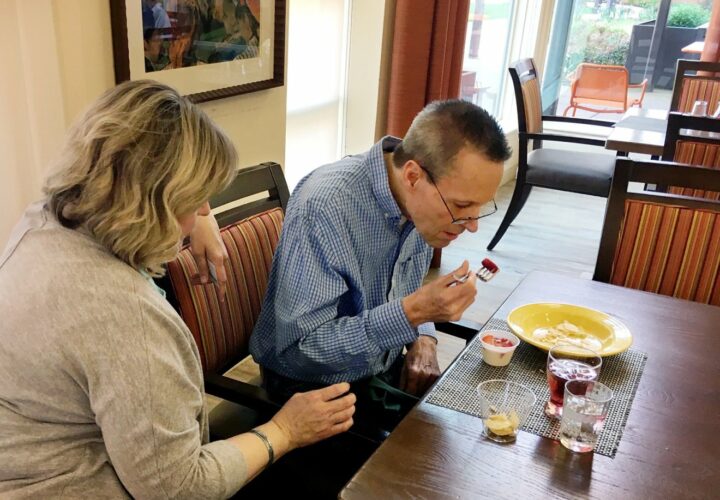Research shows that mindfulness techniques can help relieve stress and depression for dementia caregivers.
Mindfulness is a practice of being in the present moment. It is deeply rooted in ancient tradition, but in recent years, scientists have been gaining more insights into its modern-day health benefits.
The stress of caring for a loved one with dementia often take a big toll on the body, mind and spirit. But research of caregivers to people living with dementia shows that mindfulness-based interventions could relieve their stress and depression, and improve overall mental health.
According to psychologist Dale Atkins, care partners are often in a state of hypervigilance. Practicing mindfulness can help anchor caregivers in the present moment, steering them from feeling on edge, she explained.
“[Mindfulness] helps you avoid catastrophizing what might be in the future, or dwelling in the past,” Atkins told Being Patient. “It enables you to develop a sense of calm, because typically you focus on your breath and other sensations in the body, so that you can quiet a mind that can be very restless, anxious [and] scared. Mindfulness really can be a wonderful path to restoring your sense of wellbeing.”
Here are a few things Atkins shared to bring mindfulness into daily life.
1. Start with small, simple mindfulness techniques
Formal meditation is a way to foster mindfulness, but practicing mindfulness can also be as simple as finding moments in our routine to stay present.
“Mindfulness helps you avoid catastrophizing
what might be in the future, or dwelling in the past.”
“Stop what you’re doing for the moment, and take a breath,” Atkins said, “and then focus on the breath.”
Put a hand on your belly, she continued, feel it going up and down, and sense of the air coming in and out of your nostrils. Then, observe how you’re feeling. Perhaps you’re thirsty, hungry or tired after a long day.
Taking a pause, breathing and recognizing our feelings helps us find value in reserving time for replenishment, Atkins explained. That could mean listening to music, calling a loved one or simply brewing a cup of tea. And practicing mindfulness can extend to anything that we do in daily life. When it comes to mindful eating, for instance, engage the senses by noticing the colors, arrangement and aroma of a meal, Atkins said. Eat slowly, and take note of the food’s taste and texture. Appreciate the meal in front of you.
2. Explore formal meditation exercises
Generally, Atkins said bookending the day with a meditation is helpful as care partners can be exhausted by night and overwhelmed when they wake up in the morning.
As a way to prepare for a meditation, relax, scan the body from head to toe, recognize any aches and take deep breaths, she noted. When the mind wanders, bring your focus back to the breath without criticism.
Among the different forms of meditation is the loving-kindness meditation, which centers on cultivating compassion. Again, there are many ways to practice this meditation. But its core technique involves sending wishes of wellbeing to yourself, to loved ones, then to people that you may not know well, and ultimately, to all living beings.
“[The loving-kindness meditation] reminds you that you’re connected, that you’re not so alone,” Atkins said.
“It also gives the person the sense that ‘I can do something even if I can’t change the situation. It’s not within my power to change the situation,” she continued. “‘But I can send out this positive, loving-[kindness] energy.’”
The living-kindness meditation is both powerful and accessible for caregivers, helping them foster compassion for themselves and others, Atkins added. For care partners who feel underserved of self-compassion, she said, practicing the loving-kindness meditation can be difficult; but the tenet of meditation and mindfulness is to be present without judgment, and that whatever a person feels is okay.
3. Check out these resources
There are a wealth of resources on meditation and mindfulness. Joining local groups and classes can be great, Atkins said, though finding time for these programs isn’t always easy for care partners.
“It’s not within my power to change the
situation. But I can send out this positive,
loving-kindness energy.”
She noted that Calm, Headspace and Ten Percent Happier are all user-friendly apps that are helpful especially for beginners. For further guidance, experts like Sharon Salzberg, Jon Kabat-Zinn, Tara Brach and the late Thich Nhat Hanh all offer instructions online.
4. Practice — and don’t be hard on yourself
Mindfulness and meditation takes practice and patience. Atkins said starting small with daily practices like mindful eating, mindful walking or mindful showering, along with five to 10 minutes of meditation, can go a long way.
Don’t be critical of yourself if you miss a few days of practice, she noted. Perhaps wake up a little earlier for extra time. Give yourself another chance.



